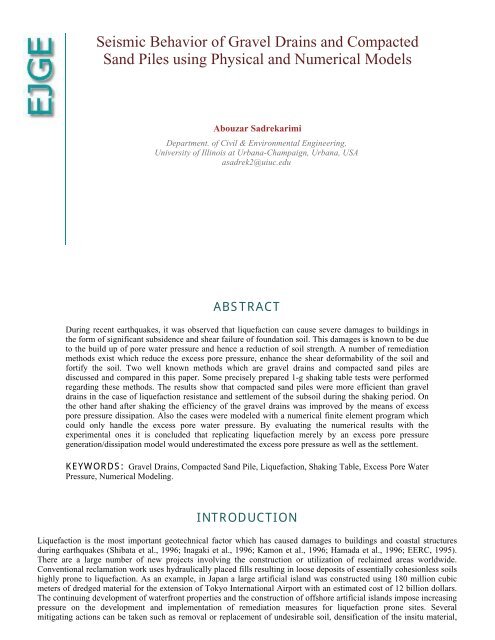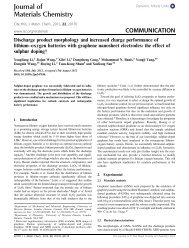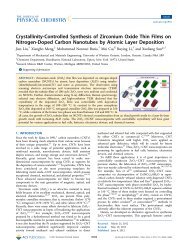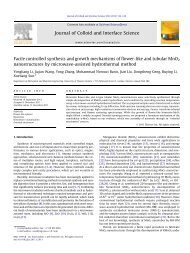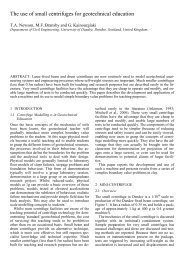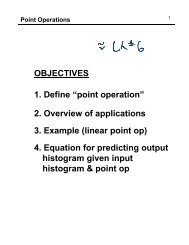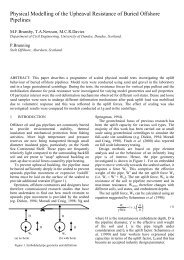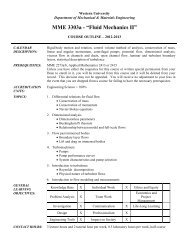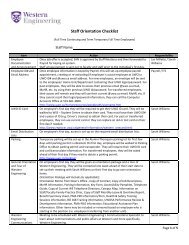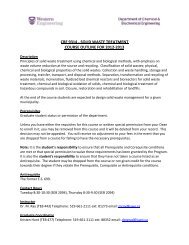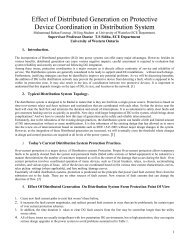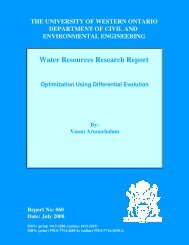Seismic Behavior of Gravel Drains and Compacted Sand Piles using ...
Seismic Behavior of Gravel Drains and Compacted Sand Piles using ...
Seismic Behavior of Gravel Drains and Compacted Sand Piles using ...
You also want an ePaper? Increase the reach of your titles
YUMPU automatically turns print PDFs into web optimized ePapers that Google loves.
<strong>Seismic</strong> <strong>Behavior</strong> <strong>of</strong> <strong>Gravel</strong> <strong>Drains</strong> <strong>and</strong> <strong>Compacted</strong><br />
S<strong>and</strong> <strong>Piles</strong> <strong>using</strong> Physical <strong>and</strong> Numerical Models<br />
Abouzar Sadrekarimi<br />
Department. <strong>of</strong> Civil & Environmental Engineering,<br />
University <strong>of</strong> Illinois at Urbana-Champaign, Urbana, USA<br />
asadrek2@uiuc.edu<br />
ABSTRACT<br />
During recent earthquakes, it was observed that liquefaction can cause severe damages to buildings in<br />
the form <strong>of</strong> significant subsidence <strong>and</strong> shear failure <strong>of</strong> foundation soil. This damages is known to be due<br />
to the build up <strong>of</strong> pore water pressure <strong>and</strong> hence a reduction <strong>of</strong> soil strength. A number <strong>of</strong> remediation<br />
methods exist which reduce the excess pore pressure, enhance the shear deformability <strong>of</strong> the soil <strong>and</strong><br />
fortify the soil. Two well known methods which are gravel drains <strong>and</strong> compacted s<strong>and</strong> piles are<br />
discussed <strong>and</strong> compared in this paper. Some precisely prepared 1-g shaking table tests were performed<br />
regarding these methods. The results show that compacted s<strong>and</strong> piles were more efficient than gravel<br />
drains in the case <strong>of</strong> liquefaction resistance <strong>and</strong> settlement <strong>of</strong> the subsoil during the shaking period. On<br />
the other h<strong>and</strong> after shaking the efficiency <strong>of</strong> the gravel drains was improved by the means <strong>of</strong> excess<br />
pore pressure dissipation. Also the cases were modeled with a numerical finite element program which<br />
could only h<strong>and</strong>le the excess pore water pressure. By evaluating the numerical results with the<br />
experimental ones it is concluded that replicating liquefaction merely by an excess pore pressure<br />
generation/dissipation model would underestimated the excess pore pressure as well as the settlement.<br />
KEYWORDS: <strong>Gravel</strong> <strong>Drains</strong>, <strong>Compacted</strong> S<strong>and</strong> Pile, Liquefaction, Shaking Table, Excess Pore Water<br />
Pressure, Numerical Modeling.<br />
INTRODUCTION<br />
Liquefaction is the most important geotechnical factor which has caused damages to buildings <strong>and</strong> coastal structures<br />
during earthquakes (Shibata et al., 1996; Inagaki et al., 1996; Kamon et al., 1996; Hamada et al., 1996; EERC, 1995).<br />
There are a large number <strong>of</strong> new projects involving the construction or utilization <strong>of</strong> reclaimed areas worldwide.<br />
Conventional reclamation work uses hydraulically placed fills resulting in loose deposits <strong>of</strong> essentially cohesionless soils<br />
highly prone to liquefaction. As an example, in Japan a large artificial isl<strong>and</strong> was constructed <strong>using</strong> 180 million cubic<br />
meters <strong>of</strong> dredged material for the extension <strong>of</strong> Tokyo International Airport with an estimated cost <strong>of</strong> 12 billion dollars.<br />
The continuing development <strong>of</strong> waterfront properties <strong>and</strong> the construction <strong>of</strong> <strong>of</strong>fshore artificial isl<strong>and</strong>s impose increasing<br />
pressure on the development <strong>and</strong> implementation <strong>of</strong> remediation measures for liquefaction prone sites. Several<br />
mitigating actions can be taken such as removal or replacement <strong>of</strong> undesirable soil, densification <strong>of</strong> the insitu material,
insitu soil improvement by grouting <strong>and</strong> chemical stabilization <strong>and</strong> <strong>using</strong> <strong>of</strong> relief wells such as gravel or rock drains for<br />
the control <strong>of</strong> undesirable pore water pressure. Although these types <strong>of</strong> mitigation techniques are developed, the<br />
effectiveness <strong>of</strong> these methods are not well defined <strong>and</strong> understood (Das, 1983).<br />
All mitigation techniques which are frequently employed to reduce large deformations <strong>and</strong> subsidence <strong>of</strong> buildings are<br />
based on the following philosophies:<br />
Reducing the build up <strong>of</strong> pore water pressure by means <strong>of</strong> quick drainage <strong>of</strong> water during <strong>and</strong> immediately after the<br />
earthquake.<br />
Improving shear deformability <strong>of</strong> the soil skeleton to prevent large cyclic deformation during the earthquake.<br />
Reinforcing the soil skeleton, which in turn can reduce both shear strain <strong>and</strong> generation <strong>of</strong> excess pore water pressure<br />
<strong>and</strong> increases the soil strength.<br />
One <strong>of</strong> the widely used mitigation methods is <strong>using</strong> gravel drains. The possible benefits <strong>of</strong> gravel drains are densification<br />
<strong>of</strong> surrounding non-cohesive soil, dissipation <strong>of</strong> excess pore water pressure <strong>and</strong> re-distribution <strong>of</strong> earthquake-induced or<br />
pre-existing stresses (due to introduction <strong>of</strong> the stiffer columns). When dealing with non-plastic silty soils, only the third<br />
benefit can be expected primarily to mitigate liquefaction (Baez, 1995). The gravel drain technique is ideally suited for<br />
improving s<strong>of</strong>t silts <strong>and</strong> clays, <strong>and</strong> loose silty s<strong>and</strong>s. The level <strong>of</strong> improvement depends on the soil type, installation<br />
technique, relative spacing <strong>of</strong> the drains, <strong>and</strong> drain diameter. Crushed stones made <strong>of</strong> recycled concrete from torn-down<br />
apartment buildings <strong>and</strong> complexes are suitable alternatives to be used as drain materials (Orense et al., 2003). <strong>Gravel</strong><br />
drains operate by providing preferential drainage paths which enable accumulated pore pressures to dissipate ideally<br />
before the surrounding soil reaches a state <strong>of</strong> initial liquefaction (Brennan <strong>and</strong> Madabhushi, 2002). One <strong>of</strong> the first<br />
studies on gravel drains as liquefaction remediation is that done by Seed <strong>and</strong> Booker (1977). Since this was published,<br />
drains have been subjected to real earthquakes, such as Koshiro-Oki (Sonu et al., 1993), Northridge (Boulanger et al.,<br />
1998) <strong>and</strong> Kobe (Yasuda et al., 1996). Several shortcomings <strong>of</strong> gravel drains have been reported in the literature. A<br />
collected experience suggests that while drains can certainly provide a solution, settlement can still occur to an<br />
unsatisfactory degree (Brennan <strong>and</strong> Madabhushi, 2002).<br />
Regarding aforesaid remarks, in the current study some aspects <strong>of</strong> the effectiveness <strong>of</strong> gravel drains <strong>and</strong> compacted s<strong>and</strong><br />
piles in mitigating excess pore water pressure <strong>and</strong> reducing the subsidence <strong>of</strong> buildings has been studied <strong>using</strong> 1g<br />
shaking table tests <strong>and</strong> following that the experimental results are compared with a numerical method which incorporates<br />
an improved procedure <strong>of</strong> that used by Seed <strong>and</strong> Booker (1977).<br />
PHYSICAL MODELING<br />
A series <strong>of</strong> shaking table tests were conducted on model gravel drains <strong>and</strong> compacted s<strong>and</strong> piles. Figure 1 shows a three<br />
dimensional view <strong>of</strong> the model. Models were constructed in a transparent plexiglass container <strong>of</strong> 180cm long, 45cm wide<br />
<strong>and</strong> 70cm high. The bottom <strong>of</strong> the container was covered by a fine screen mesh so that the saturation process could be<br />
performed by percolating water gradually <strong>and</strong> uniformly from the bottom <strong>of</strong> the soil box.
Figure 1. Three-dimensional view <strong>of</strong> the model apparatus<br />
Firuzkooh s<strong>and</strong> was used as the subsoil. The characteristics <strong>of</strong> this s<strong>and</strong> are Gs = 2.658, emax = 0.943, emin = 0.603,<br />
D50 = 0.3mm, Cu = 2.58, Cc = 0.97 <strong>and</strong> permeability <strong>of</strong> 0.0125 cm/sec. The model foundation had dimensions <strong>of</strong><br />
20cmx30cm <strong>and</strong> was applying an overburden pressure <strong>of</strong> 3 kPa on the s<strong>and</strong>. A geometrical scaling factor <strong>of</strong> 1:25 can be<br />
assumed throughout these tests to model a prototype with a width <strong>of</strong> 5m. Different types <strong>of</strong> transducers were employed<br />
to measure acceleration, pore water pressure <strong>and</strong> displacement at different positions as shown in Figure 2. The pore<br />
pressure transducers were fixed in place to record the pore water pressures at the exact locations; however the<br />
acceleration transducers were free to move with the adjacent soil.<br />
Moist tamping method, in which the Firuzkooh s<strong>and</strong> was mixed with 5% moisture, was used to prepare a uniform soil<br />
pr<strong>of</strong>ile. Wet Firuzkooh s<strong>and</strong> was poured inside the container <strong>and</strong> carefully tamped to a total unit weight <strong>of</strong> 14.41 kN/m3,<br />
thus a target void ratio <strong>of</strong> 0.9 was gained for the liquefiable soil through the tests. Dyed grid lines were created to make<br />
the behavior <strong>of</strong> model ground visible. The soil models were percolated with carbon dioxide to help dissolve the air in the<br />
void space, in order to facilitate full saturation by water. Afterwards the model was saturated from bottom with a very<br />
slow steady flow <strong>of</strong> water in order to sustain the controlled density <strong>of</strong> the tamped s<strong>and</strong>. Input shaking in all tests was a<br />
harmonic wave. The frequency <strong>of</strong> shaking <strong>and</strong> amplitude <strong>of</strong> base acceleration were 3 Hz <strong>and</strong> 0.28g respectively.<br />
Figure 2. Schematic view <strong>of</strong> the model <strong>and</strong> transducers (A1~A4: Accelerometers, P1~P5: Pore water pressure<br />
transducers <strong>and</strong> D1:Displacement transducer)<br />
Test O was performed without any improvements; in test G gravel drains were placed in the model ground. These gravel<br />
drains had a diameter <strong>of</strong> 5cm <strong>and</strong> were s<strong>and</strong>wiched by geo-textile filters. The longitudinal <strong>and</strong> transverse center-to-center<br />
spacing <strong>of</strong> these drains was 25cm <strong>and</strong> 30cm respectively. Dynamic compaction in test C was applied by dropping a 2.0
kg weight with a circular bottom area <strong>of</strong> 19.6cm2 from a height <strong>of</strong> 30cm, ten times. The ground could be improved to a<br />
depth <strong>of</strong> almost 30cm in model scale <strong>using</strong> this method. The resulting compacted s<strong>and</strong> piles had a relative density <strong>of</strong><br />
about 65-70%. Relative densities as high as 90% can be achieved in field with crushed stones (Adalier et al., 2003). The<br />
center-to-center distance <strong>of</strong> the piles was 5cm. These piles covered an abscissa <strong>of</strong> 1B. Figure 3 schematically shows<br />
different types <strong>of</strong> models as described above. A dynamic data acquisition system was utilized to record the behavior <strong>of</strong><br />
the model during the test. During all tests, data were recorded at a sampling rate <strong>of</strong> 1000 samples per second.<br />
Figure 3. Schematic views <strong>of</strong> test arrangements.<br />
NUMERICAL MODELING<br />
The conducted experiments were simulated with a two-dimensional finite element code (FEQDrain) programmed by<br />
Pestana et al. (1998). This program allows for generation <strong>and</strong> dissipation <strong>of</strong> the pore water pressure during dynamic<br />
loading, <strong>and</strong> the basic differential equation is the one used by Seed <strong>and</strong> Booker (1977), <strong>and</strong> Onoue (1988) with some<br />
modifications in the treatment <strong>of</strong> boundary conditions <strong>and</strong> drain elements, which are as below:
Where u is the pore water pressure, t is time, mv is the coefficient <strong>of</strong> volumetric compressibility, ?w is the unit weight <strong>of</strong><br />
water, z is depth within the soil, <strong>and</strong> k is the coefficient <strong>of</strong> permeability. The last term, ?ug/?t, is the undrained rate <strong>of</strong><br />
pore pressure buildup which is calculated through empirical findings <strong>of</strong> development <strong>of</strong> pore water pressure in granular<br />
soils under cyclic loading conditions.<br />
The above relation is an empirical relationship <strong>and</strong> ? is the empirical constant, which depends on the soil type. N is the<br />
number <strong>of</strong> uniform shear stress cycles undergone by the soil at the given depth during the earthquake loading <strong>and</strong> N1 is<br />
the number <strong>of</strong> cycles at the same stress level required to cause liquefaction under undrained conditions (EERC, 1975).<br />
<strong>Drains</strong> can be modeled in four different ways. In the first case, there is no drain, thus allowing the site to be analyzed<br />
prior to remediation. The second method uses a “perfect” drain, similar to the LARF (EERC, 1976) code, in which<br />
excess pore pressures below the water table are assumed uniform. Thus, if the water level in the drain starts out at the<br />
ground surface, the excess pore pressures in the drain will always be zero. If however, the water level is below the<br />
ground surface, water can accumulate within the drain, leading to a uniform rise in the excess pore pressures within the<br />
drain, thus retarding subsequent entry <strong>of</strong> water. The third approach follows an Onoue-type analysis (Onoue, 1988) in<br />
which the drain is represented by a soil element with both horizontal <strong>and</strong> vertical hydraulic conductivities which can be<br />
set independently <strong>of</strong> the soil outside the drain. Thus, a very high permeability channel can be created. As in the “perfect”<br />
drain method, the code has the additional capability for allowing water to accumulate within the drain itself. The<br />
boundary conditions are as Figure 4.<br />
The input parameters were applied as following. Only one layer in the soil pr<strong>of</strong>ile was defined due to the relatively<br />
uniform s<strong>and</strong> deposit prepared throughout the tests. The depth to static ground water table was set to zero since water<br />
level was at the ground surface in the model tests. An effective vertical stress <strong>of</strong> 3 kPa was used to model the foundation<br />
overburden pressure <strong>and</strong> a hydraulic conductivity <strong>of</strong> 1.25x10-4 m/s was assigned. Also coefficient <strong>of</strong> volumetric<br />
compressibility <strong>of</strong> 5x10-5 m2/kN was used, provided by some consolidation experiments carried out on Firuzkooh s<strong>and</strong>.<br />
The number <strong>of</strong> cycles to cause liquefaction in each test was extracted from the acceleration time history response.<br />
Equivalent number <strong>of</strong> cycles due to earthquake loading was selected from the recorded input acceleration time history<br />
(acceleration transducer A4) <strong>of</strong> each test <strong>and</strong> 10 second duration was used. According to tests specifications relative<br />
density (Dr), total layer thickness <strong>and</strong> total unit weight <strong>of</strong> 12.65%, 0.6 m <strong>and</strong> 18.56 KN/m3 were used respectively. An<br />
axisymmetric analysis with a variable compressibility was performed. The gravel drains were modeled with a constant<br />
hydraulic conductivity <strong>of</strong> 0.25 m/s, an outside radius <strong>of</strong> 2.5 cm <strong>and</strong> a tributary area radius <strong>of</strong> 20.34 cm according to the<br />
experiments. Besides, the compacted s<strong>and</strong> piles were modeled as uniform soils with higher relative densities <strong>and</strong> less<br />
hydraulic conductivities.<br />
(1)<br />
(2)<br />
(3)<br />
(4)
Experimental results<br />
Acceleration time histories<br />
Figure 4. Boundary conditions used in the numerical modeling (EERC, 1997)<br />
The acceleration responses <strong>of</strong> the models are shown in Figures 5-7. A very clear reduction <strong>of</strong> acceleration occurred after<br />
the second cycle in test O (Figure 6) which indicates severe liquefaction <strong>and</strong> s<strong>of</strong>tening <strong>of</strong> the soil particularly at the<br />
positions <strong>of</strong> A1 <strong>and</strong> A2. This kind <strong>of</strong> s<strong>of</strong>tening also happened in test G (Figure 6) after the seventh cycle. The presence<br />
<strong>of</strong> gravel drains delayed the s<strong>of</strong>tening <strong>of</strong> the soil; however it didn’t mitigate it completely. The larger amplitudes <strong>of</strong><br />
acceleration response in test G implies that the seismic shaking was transferred, with some amplification from the base<br />
<strong>of</strong> the deposit up to the footing by the composite ground <strong>of</strong> s<strong>and</strong> <strong>and</strong> gravel drains. The loss <strong>of</strong> strength in test G was<br />
larger <strong>and</strong> faster than that in test C (Figure 7). At corresponding locations, attenuations were smaller <strong>and</strong> delayed in test<br />
C comparing to tests G <strong>and</strong> O. This can be attributed to the reinforcing effect <strong>of</strong> the compacted s<strong>and</strong> piles. In general,<br />
throughout shaking, model test C behaved in a stiffer manner <strong>and</strong> the cyclic mobility induced s<strong>of</strong>tening occurred<br />
gradually after eight cycles <strong>of</strong> shaking in shallower depths <strong>of</strong> A1 <strong>and</strong> A2. <strong>Compacted</strong> s<strong>and</strong> piles due to their dilative<br />
characteristic appeared to be stronger <strong>and</strong> degradation <strong>of</strong> their strength was not very significant. The spikier <strong>and</strong> an<br />
overall stiffer response <strong>of</strong> the compacted s<strong>and</strong> piles exhibit a more pronounced cyclic-mobility behavior <strong>of</strong> the stratum.<br />
This cyclic mobility behavior explains why the accelerations reduce at a later time than those <strong>of</strong> the unremediated<br />
ground.
Figure 5. Time histories <strong>of</strong> accelerations recorded in Test O<br />
Figure 6. Time histories <strong>of</strong> accelerations recorded in Test G
Excess pore water pressure<br />
Figure 7. Time histories <strong>of</strong> accelerations recorded in Test C<br />
Time histories <strong>of</strong> excess pore pressure ratio, ru, recorded at depths <strong>of</strong> 15cm <strong>and</strong> 35cm below the center <strong>of</strong> the foundation<br />
are shown in Figures 8-10. Comparing these figures with the acceleration time histories indicates that acceleration<br />
amplitudes attenuated due to excess pore pressure buildup since the chronological agreement between the maximum<br />
excess pore pressure <strong>and</strong> the attenuation <strong>of</strong> acceleration amplitude is clearly seen from these figures. Maximum excess<br />
pore pressure ratio (ru) was achieved during some initial cycles <strong>and</strong> remained almost unchanged within the shaking<br />
period. The maximum excess pore pressure ratios in all tests, were almost the same however, the number <strong>of</strong> cycles<br />
ca<strong>using</strong> this maximum ru was different. The gravel drains increased the resistance against liquefaction <strong>and</strong> ru reached its<br />
maximum within a larger number <strong>of</strong> cycles. A similar behavior was observed in test C with the compacted subsoil.<br />
Compaction was able to increase liquefaction resistance more than gravel drains. During shaking, gravel drains were not<br />
able to reduce the excess pore pressure considerably; <strong>and</strong> changes in the behavior <strong>of</strong> the remediated ground was<br />
primarily a result <strong>of</strong> the stiffening effect <strong>of</strong> the gravel drains.<br />
After the shaking excess pore water pressures at deeper locations started to dissipate, however they increased in<br />
shallower deposits due to the upward movement <strong>of</strong> water from deeper strata <strong>and</strong> flows draining from the surrounding far<br />
field soils; such a phenomenon was also observed by Liu <strong>and</strong> Dobry (1997) as well as during the 1995 Kobe earthquake,<br />
where upward seepage was observed in Rokko Isl<strong>and</strong> an hour after the main event (Shibata et al., 1996). This migration<br />
<strong>of</strong> water may reduce the strength <strong>of</strong> surface soils <strong>and</strong> generate "secondary" (or seepage induced) liquefaction, ca<strong>using</strong><br />
large deformations or loss <strong>of</strong> bearing capacity (EERC, 1975; Yoshimi <strong>and</strong> Kuwabara, 1973).<br />
Furthermore the excess pore water pressure ratios show that at any specific depth there was a moment after which, the<br />
excess pore pressures started to dissipate faster. This is the initial period, where vertical dissipation had not had a chance<br />
to get hold on the soil at that corresponding depth <strong>and</strong> only radial drainage was experienced at that depth.<br />
After shaking the differences in dissipation rates <strong>of</strong> various tests were remarkable which indicates that gravel drains<br />
accelerated the excess pore pressure dissipation after shaking, showing their effectiveness in non-dynamic cases i.e.<br />
effectively mitigating secondary liquefaction due to the upward flowing water after earthquake. The deeper pore water<br />
pressure used the full drain capacity <strong>and</strong> overlying deposits waited for the way to be clear. At shallower sections water<br />
left through surface rather than the drain itself. Such phenomenon was also observed by Brennan <strong>and</strong> Madabhushi<br />
(2002).
Figure 8. Time histories <strong>of</strong> excess pore pressure ratio under the foundation centerline in Test O<br />
Figure 9. Time histories <strong>of</strong> excess pore pressure ratio under the foundation centerline in Test G
Figure 2. Figure 10: Time histories <strong>of</strong> excess pore pressure ratio under the foundation centerline in Test C<br />
Figure 11. Excess pore water pressure ratio isopiestic lines in Test O
Figure 12. Excess pore water pressure ratio isopiestic lines in Test G<br />
Figure 13. Excess pore water pressure ratio isopiestic lines in Test C<br />
The isopiestic lines for excess pore water pressure ratio, five seconds after the shaking had started, are depicted in<br />
Figures 11-13. It can be observed that the excess pore water pressures right under the foundation never reached zero<br />
effective stress conditions in any <strong>of</strong> the tests <strong>and</strong> the corresponding excess pore pressure ratios never gained a value <strong>of</strong><br />
100%. This is due to the presence <strong>of</strong> foundation, other wise the shaking intensity was enough to develop complete<br />
liquefaction. Looking at the locations farther from the effect <strong>of</strong> the foundation, shows that achieving higher excess pore<br />
water pressure ratios was possible. In other words, ru values were lowest immediately below the foundation, revealing a
significantly less contractive soil response within the foundation soil. If there was no foundation placed on the soil the<br />
soils at shallower depths would be more susceptible to liquefy than soils at deeper depths. Centrifuge <strong>and</strong> other 1g<br />
shaking table tests on foundations supported by s<strong>and</strong>y deposits have shown that excess pore water pressure was generally<br />
smaller under the foundation than the free field (Laak et al., 1994; Whitman <strong>and</strong> Lambe, 1988; Liu <strong>and</strong> Dobry, 1997;<br />
Adalier et al., 1998; Adalier et al., 2002; Koga <strong>and</strong> Matsuo, 1990) i.e. the superposed footing loads caused a beneficial<br />
reduction <strong>of</strong> liquefaction potential. This is similar to sloping ground conditions, in which the maximum achievable pore<br />
water pressures are suppressed by the static driving shear stress <strong>and</strong> may not reach full liquefaction, no matter how many<br />
additional loading cycles are applied. Koga <strong>and</strong> Matsuo (1990) attributed it to the inability <strong>of</strong> the earlier liquefied freefield<br />
soil to provide lateral stress more than its initial vertical effective stress to the foundation soil.<br />
Settlement<br />
Earthquake induced settlement frequently causes damages to structures supported on shallow foundations, damage to<br />
utilities that serve pile-supported structures, <strong>and</strong> damage to lifelines that are commonly buried at shallow depths. Failure<br />
is observed in the form <strong>of</strong> considerable subsidence due to the following reasons:<br />
S<strong>of</strong>tening <strong>of</strong> the subsoil resulting in lateral deformations <strong>of</strong> the soil which can be indicated by the curved shapes <strong>of</strong> the<br />
dyed s<strong>and</strong> under the footing in Figure 14.<br />
Loss <strong>of</strong> shear strength, which causes a punching settlement <strong>of</strong> the model foundation.<br />
General settlement <strong>of</strong> subsoil following liquefaction, which is caused by excess pore pressure dissipation during <strong>and</strong><br />
after the earthquake.<br />
Earthquake shaking causes excess pore pressure to build up under undrained conditions, thereby reducing the effective<br />
stress. The excess pore pressure produces a hydraulic gradient that drives the pore water out <strong>of</strong> the voids. The flow <strong>of</strong><br />
water reduces the hydraulic gradient until the excess pore pressure completely dissipates. As the water flows from the<br />
voids, the volume <strong>of</strong> the soil decreases. The magnitude <strong>of</strong> the volume change increases with the magnitude <strong>of</strong> the<br />
seismically induced excess pore pressure. Even small excess pore pressures which may not be sufficient to produce flow<br />
liquefaction or cyclic mobility, can produce some post-earthquake settlements. The time required for this settlement to<br />
occur depends on the permeability <strong>and</strong> compressibility <strong>of</strong> the soil, <strong>and</strong> on the length <strong>of</strong> the drainage path (Kramer, 1996).<br />
Among the mentioned reasons, the effects <strong>of</strong> the first <strong>and</strong> second mechanisms were more remarkable.
Figure 14. Failure patterns observed after shaking <strong>of</strong> (a) Test O, (b) Test G<br />
Figure 15 shows the recorded time histories <strong>of</strong> foundation settlements. The initial settlement rate <strong>of</strong> tests O <strong>and</strong> G was<br />
larger than that <strong>of</strong> test C; however after this initial fast settlement the settlement rates in all <strong>of</strong> the tests become very<br />
similar. This implies a similar initial settlement mechanism in tests O <strong>and</strong> G which because <strong>of</strong> its high rate can be<br />
attributed to a loss <strong>of</strong> shear strength <strong>and</strong> punching type <strong>of</strong> settlement. This observation is analogical to the behavior <strong>of</strong><br />
the response acceleration <strong>and</strong> excess pore pressure ratio which were discussed earlier. Due to the larger voids in gravel<br />
drains this type <strong>of</strong> settlement was larger in gravel drains. Afterwards the rate <strong>and</strong> mechanisms <strong>of</strong> settlement becomes a<br />
s<strong>of</strong>tening type in all <strong>of</strong> the tests which was manifested by lateral deformations in the subsoil as shown in Figure 14 for<br />
tests O <strong>and</strong> G. Furthermore the amount <strong>of</strong> settlement due to s<strong>of</strong>tening <strong>and</strong> lateral deformation in all <strong>of</strong> the tests was<br />
almost the same <strong>and</strong> equal to 50mm. This can be justified by the same amount <strong>of</strong> the maximum pore water pressure ratio<br />
developed in all <strong>of</strong> the tests.<br />
Settlement in test C seems to be reasonably controlled. Compaction could reduce the rate <strong>and</strong> the maximum amount <strong>of</strong><br />
settlement as well as delaying the settlement initiation time. Figure 10 shows an initial negative excess pore water<br />
pressure developed at 15 cm below the foundation centerline in test C <strong>and</strong> correspondingly the ground surface was<br />
observed to have a smaller subsidence. Settlement in test C was due to the migration <strong>of</strong> underlying foundation soil<br />
towards the free field <strong>and</strong> was partially masked by heave.
Figure 15. Foundation settlements observed in different tests<br />
In all <strong>of</strong> the tests regarding the ten second shaking period, most <strong>of</strong> the foundation settlements occurred during shaking,<br />
<strong>and</strong> a smaller portion <strong>of</strong> the total settlement was caused by post-shaking soil reconsolidation due to excess pore water<br />
pressure dissipation. The less efficiency <strong>of</strong> gravel drains can be realized by comparing these two phenomena that excess<br />
pore water pressure was reduced mostly after shaking <strong>and</strong> most <strong>of</strong> the settlement occurred during shaking. However,<br />
more recently, gravel drains have been used to reduce post-earthquake settlements resulting from soil consolidation due<br />
to excess pore pressure dissipation <strong>and</strong> secondary liquefaction (EERC, 1997).<br />
NUMERICAL RESULTS<br />
The numerical analysis presented in figures 16-18 illustrate that the numerical method was only able to predict the excess<br />
pore pressure ratio correctly in test O. In the other tests <strong>using</strong> gravel drains <strong>and</strong> compacted s<strong>and</strong> piles, the computed<br />
excess pore pressure ratios were much smaller than the measured values. However the trends in each test were predicted<br />
correctly i.e. the excess pore pressure ratios in deeper layers were larger than those in shallower layers.
Figure 16. Time histories <strong>of</strong> excess pore pressure ratio under the center <strong>of</strong> foundation by the numerical analyzing <strong>of</strong> Test<br />
O<br />
Figure 17. Time histories <strong>of</strong> excess pore pressure ratio under the center <strong>of</strong> foundation by the numerical analyzing <strong>of</strong> Test<br />
G
Figure 18. Time histories <strong>of</strong> excess pore pressure ratio under the center <strong>of</strong> foundation by the numerical analyzing <strong>of</strong> Test<br />
C<br />
By not considering the s<strong>of</strong>tening <strong>and</strong> loss <strong>of</strong> strength <strong>of</strong> the subsoil, which had a significant contribution in foundation<br />
settlements, the computed settlements were much smaller than the recorded values in Figure 19. Ignoring the loss <strong>of</strong><br />
shear strength mechanism has made the settlement <strong>of</strong> the gravel drains to be much smaller than the non-remediated case.<br />
However the efficiency <strong>of</strong> the compacted piles in reducing the rate <strong>and</strong> amount <strong>of</strong> settlement is demonstrated in the<br />
numerical simulations too.<br />
Figure 19. Foundation settlement in different tests obtained by numerical analysis.
Figure 20. Excess pore water pressure ratio isopiestic lines from numerical simulation <strong>of</strong> Test O.<br />
Figure 21. Excess pore water pressure ratio isopiestic lines from numerical simulation <strong>of</strong> Test G.
Figure 22. Excess pore water pressure ratio isopiestic lines from numerical simulation <strong>of</strong> Test C.<br />
The isopiestic lines <strong>of</strong> the excess pore water pressure ratios, obtained from the numerical simulations, are depicted in<br />
Figures 20-22, <strong>and</strong> can be compared with their counterparts in Figures 11-13. Higher excess pore pressure ratios in test O<br />
<strong>and</strong> lower ones in tests G <strong>and</strong> C are the effects <strong>of</strong> the ground remediation. The numerical code applies the overburden<br />
pressure uniformly all over the surface, that's why the contours are not the same shape as the actual ones in Figures 11-<br />
13, especially in tests O <strong>and</strong> C. However, in corresponding depths the computed excess pore water pressure ratios agreed<br />
very well with the actual ones in test O but in tests G <strong>and</strong> C they were much less than the real values. In addition the<br />
numerical code was not able to simulate the dilative response <strong>and</strong> the consequent negative excess pore pressure beneath<br />
the foundation in test C. Besides the pore pressure reduction capability <strong>of</strong> the gravel drains was expressed by the<br />
numerical simulation.<br />
CONCLUSIONS<br />
A series <strong>of</strong> 1g shaking table tests were carried out to evaluate the performance <strong>of</strong> two common ground improvement<br />
techniques, gravel drains <strong>and</strong> s<strong>and</strong> compacted piles. For comparison a test with no improvement was also performed to<br />
compare the behaviors. Following the experimental work, these techniques were modeled with a finite element code.<br />
The experiments presented that the improvement provided by the dynamic compaction method not only reduces the<br />
excess pore pressure, but also the stiffer compacted s<strong>and</strong> piles provided higher overall foundation shear strength <strong>and</strong><br />
bearing capacity, preventing settlements better than gravel drains. Settlement was mainly due to migration <strong>of</strong> underlying<br />
foundation soil towards the free field (lateral spreading) in the tests with s<strong>and</strong> compacted piles. However with the gravel<br />
drains, the settlement was considerably raised due to the loss <strong>of</strong> shear strength <strong>and</strong> punching attained by the shaking<br />
process. Since gravel is a frictional material possessing negligible cohesion, confining pressure applied by the soil is <strong>of</strong><br />
paramount importance. Sufficient vertical stress or confining pressure might be required to engage the full reinforcing<br />
effect <strong>of</strong> the gravel drains. This confinement can be obtained with the weight <strong>of</strong> the structure <strong>and</strong> method <strong>of</strong> installation.<br />
The installation process should embed the drains tightly within the soil matrix, while preventing mixing <strong>of</strong> the in-situ<br />
s<strong>of</strong>t soil with the drain material. Such contamination not only compromises the strength <strong>of</strong> the columns, but also reduces<br />
their drainage capacity. Furthermore it was observed that the intensity <strong>of</strong> shaking was enough to produce liquefaction,<br />
however the excess pore pressure ratio never reached 100% under the center <strong>and</strong> edge <strong>of</strong> the foundation due to the static<br />
driving shear stress.<br />
In general, the test results suggest that compacted s<strong>and</strong> columns as stiffer elements are likely to be more viable solutions<br />
in mitigating liquefaction where the only possible mitigation benefit is from the stiffening stress concentration criterion.
The real advantages <strong>of</strong> drains may lie not in preventing liquefaction but in reducing the time that deposits spend in a<br />
liquefied state. This should prevent problems caused by prolonged post-earthquake excess pore pressures <strong>and</strong> secondary<br />
liquefaction, such as rotation <strong>of</strong> bridge piers or high backfill pressures behind quay walls <strong>and</strong> this implies that the<br />
efficiency <strong>of</strong> gravel drains would be improved in small duration earthquakes.<br />
The numerical analysis illustrated that simulating the liquefaction phenomenon by only considering pore pressure<br />
generation <strong>and</strong> dissipation, would be far from the margins <strong>of</strong> safety, especially in the remediated cases. Finally it should<br />
be emphasized that the effectiveness <strong>of</strong> the improvement methods depends not only on the mechanism <strong>of</strong> their behavior<br />
but also on the quality <strong>and</strong> quantity <strong>of</strong> the employed techniques.<br />
REFERENCES<br />
Adalier, K., A. Elgamal, <strong>and</strong> G.R. Martin ((1998) “Foundation liquefaction countermeasures for earth<br />
embankments.” Journal <strong>of</strong> Geotechnical & Geoenvironmental Engineering, ASCE, Vol. 124, No.6, 500-517.<br />
Adalier, K., A. Elgamal, J. Meneses, <strong>and</strong> J.I. Baez ((2003) “Stone columns as liquefaction countermeasure in nonplastic<br />
silty soils.” Soil Dynamics <strong>and</strong> Earthquake Engineering, Vol. 23, 571-584.<br />
Adalier, K., T.F. Zimmie, <strong>and</strong> A. Pamuk ((2002) “<strong>Seismic</strong> behavior <strong>of</strong> rubble-mound moles on s<strong>and</strong>y marine<br />
deposits.” Proceedings <strong>of</strong> the 21st International Conference on Offshore Mechanics <strong>and</strong> Arctic Engineering, Oslo,<br />
281-289.<br />
Baez, J.I. (1995) “A design model for the reduction <strong>of</strong> soil liquefaction by vibro-stone columns.” University <strong>of</strong><br />
Southern California, PhD Thesis.<br />
Boulanger, R.W., I.M. Idriss, D.P. Stewart, Y. Hashash <strong>and</strong> B. Schmidt (1998) “Drainage capacity <strong>of</strong> stone<br />
columns or gravel drains for mitigating liquefaction.” ASCE Geotechnical Special Publication, Vol. 75, No.1,<br />
678-690.<br />
Brennan, A.J., <strong>and</strong> S.P.G. Madabhushi (2002) “Effectiveness <strong>of</strong> vertical drains in mitigation <strong>of</strong> liquefaction.” Soil<br />
Dynamics <strong>and</strong> Earthquake Engineering, Vol. 22, 1059-1065.<br />
Das, B.M. (1983) “Fundamentals <strong>of</strong> Soil Dynamics.” Elsevier Science, New York.<br />
Earthquake Engineering Research Center (1997) “FEQDrain: A finite element computer program for the analysis<br />
<strong>of</strong> the earthquake generation <strong>and</strong> dissipation <strong>of</strong> pore water pressure in layered s<strong>and</strong> deposits with vertical drains.”<br />
EERC, University <strong>of</strong> California, Berkeley, CA, Report No. EERC 97-15.<br />
Earthquake Engineering Research Center (1995) “Geotechnical reconnaissance <strong>of</strong> the effects <strong>of</strong> the January 17,<br />
1995 Hyogoken-Nanbu earthquake, Japan.” EERC, University <strong>of</strong> California, Berkeley, CA, Report No. EERC 95-<br />
01.<br />
Earthquake Engineering Research Center (1976) “Stabilization <strong>of</strong> Potentially Liquefiable Deposits Using <strong>Gravel</strong><br />
Drain Systems” EERC, University <strong>of</strong> California, Berkeley, CA, Report No. EERC 76-10.<br />
Earthquake Engineering Research Center (1975) “The generation <strong>and</strong> dissipation <strong>of</strong> pore water pressure during<br />
soil liquefaction” EERC, University <strong>of</strong> California, Berkeley, CA, Report No. EERC 75-26.<br />
Hamada, M., R. Isoyama, <strong>and</strong> K. Wakamatsu (1996) “Liquefaction-induced ground displacement <strong>and</strong> its related<br />
damage to lifeline facilities” Soils <strong>and</strong> Foundations, Special issue on the geotechnical aspects <strong>of</strong> the January, 17<br />
1995 Hyogoken-Nanbu earthquake, 81-97.<br />
Inagaki, H., S. Iai, T. Sugano, H. Yamazaki, <strong>and</strong> T. Inatomi (1996) “Performance <strong>of</strong> Caisson Type Quay Walls at<br />
Kobe Port” Soils <strong>and</strong> Foundations, Special issue on the geotechnical aspects <strong>of</strong> the January, 17 1995 Hyogoken-<br />
Nanbu earthquake, 119-136.<br />
Kamon, M., T. Wako, K. Isemura, K. Sawa, M. Mimura, K. Tateyama, <strong>and</strong> S. Kobayashi (1996) “Geotechnical<br />
Disasters on the Waterfront.” Soils <strong>and</strong> Foundations, Special issue on the geotechnical aspects <strong>of</strong> the January, 17<br />
1995 Hyogoken-Nanbu earthquake, 137-147.
Koga, Y. <strong>and</strong> O. Matsuo (1990) “Shaking table tests <strong>of</strong> embankments resting on liquefiable s<strong>and</strong>y ground.” Soils<br />
& Foundations, Vol. 30, No.4, 162-174.<br />
Kramer, S.L. (1996) “Geotechnical Earthquake Engineering” Prentice-Hall, New Jersey.<br />
Laak, V.P., A.W. Elgamal <strong>and</strong> R. Dobry (1994) “Design <strong>and</strong> performance <strong>of</strong> an electro-hydraulic shaker for the<br />
RPI centrifuge.” Proceedings <strong>of</strong> the Centrifuge' 94, 139-144.<br />
Liu, L., <strong>and</strong> R.Dobry (1997) “<strong>Seismic</strong> response <strong>of</strong> shallow foundation on liquefiable s<strong>and</strong>.” Journal <strong>of</strong><br />
Geotechnical & Geoenvironmental Engineering, ASCE, Vol. 123, No.6, 557-567.<br />
Onoue, A. (1988) “Diagrams Considering Well Resistance for Designing Spacing Ratio <strong>of</strong> <strong>Gravel</strong> <strong>Drains</strong>.” Soils<br />
<strong>and</strong> Foundations, Vol. 28, No.3, 160-168.<br />
Orense, R.P., I. Morimoto, T. Yamamoto, T. Yumiyama, H. Yamamoto, <strong>and</strong> K. Sugawara (2003) “Study on wall<br />
type gravel drains as liquefaction countermeasure for underground structures.” Soil Dynamics <strong>and</strong> Earthquake<br />
Engineering, Vol. 23, 19-39.<br />
Pestana, J.M., C.E. Hunt, A.M. Kammerer, <strong>and</strong> R.R. Goughnour (1998) “Use <strong>of</strong> Prefabricated <strong>Drains</strong> with<br />
Storage Capacity for Reduction <strong>of</strong> Liquefaction Potential.” Geotechnical Engineering Report, University <strong>of</strong><br />
California at Berkeley, CA, UCB/GT/98.<br />
Seed, H.B., <strong>and</strong> J.R. Booker (1977) “Stabilization <strong>of</strong> potentially liquefiable s<strong>and</strong> deposits.” Journal <strong>of</strong><br />
Geotechnical Division, ASCE, Vol. 103, No.7, 757-768.<br />
Shibata, T., F. Oka <strong>and</strong> Y. Ozawa (1996) “Characteristics <strong>of</strong> ground deformation due to liquefaction.” Soils <strong>and</strong><br />
Foundations, Special issue on the geotechnical aspects <strong>of</strong> the January, 17 1995 Hyogoken-Nanbu earthquake, 65-<br />
79.<br />
Sonu, C.J., K. Ito, H. Oishi, <strong>and</strong> H.Seed (1993) “Liquefaction <strong>and</strong> the gravel drain.” Civil Engineering, Vol. 63,<br />
No.12, 58-60.<br />
Whitman, R.V., <strong>and</strong> P.C. Lambe (1988) “Earthquake like shaking <strong>of</strong> a structure founded on saturated s<strong>and</strong>.”<br />
Proceedings <strong>of</strong> the International Conference on Geotechnical Centrifuge Modeling, Paris, 529-538.<br />
Yasuda, S., K. Ishihara, K. Harada, <strong>and</strong> N. Sinkawa (1996) “Effect <strong>of</strong> soil improvement on ground subsidence due<br />
to liquefaction.” Soils <strong>and</strong> Foundations, Special issue on the geotechnical aspects <strong>of</strong> the January 17 1995<br />
Hyogoken-Nanbu earthquake, 99-108.<br />
Yoshimi, Y., <strong>and</strong> F. Kuwabara (1973) “Effects <strong>of</strong> subsurface liquefaction on the strength <strong>of</strong> surface soil.” Soils<br />
<strong>and</strong> Foundations, Vol. 13, No.2, 67-81.<br />
© 2006 ejge


